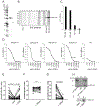High Prevalence and Disease Correlation of Autoantibodies Against p40 Encoded by Long Interspersed Nuclear Elements in Systemic Lupus Erythematosus
- PMID: 31342656
- PMCID: PMC6935427
- DOI: 10.1002/art.41054
High Prevalence and Disease Correlation of Autoantibodies Against p40 Encoded by Long Interspersed Nuclear Elements in Systemic Lupus Erythematosus
Abstract
Objective: Long interspersed nuclear element 1 (LINE-1) encodes 2 proteins, the RNA binding protein p40 and endonuclease and reverse transcriptase (open-reading frame 2p [ORF2p]), which are both required for LINE-1 to retrotranspose. In cells expressing LINE-1, these proteins assemble with LINE-1 RNA and additional RNA binding proteins, some of which are well-known autoantigens in patients with systemic lupus erythematosus (SLE). This study was undertaken to investigate whether SLE patients also produce autoantibodies against LINE-1 p40.
Methods: Highly purified p40 protein was used to quantitate IgG autoantibodies in serum from 172 SLE patients and from disease controls and age-matched healthy subjects by immunoblotting and enzyme-linked immunosorbent assay (ELISA). Preparations of p40 that also contained associated proteins were analyzed by immunoblotting with patient sera.
Results: Antibodies reactive with p40 were detected in the majority of patients and many healthy controls. Their levels were higher in patients with SLE, but not those with systemic sclerosis, compared to healthy subjects (P = 0.01). Anti-p40 reactivity was higher in patients during a flare than in patients with disease in remission (P = 0.03); correlated with the SLE Disease Activity Index score (P = 0.0002), type I interferon score (P = 0.006), decrease in complement C3 level (P = 0.0001), the presence of anti-DNA antibodies (P < 0.0001) and anti-C1q antibodies (P = 0.004), and current or past history of nephritis (P = 0.02 and P = 0.003, respectively); and correlated inversely with age (r = -0.49, P < 0.0001). SLE patient sera also reacted with p40-associated proteins.
Conclusion: Autoantibodies reacting with LINE-1 p40 characterize a population of SLE patients with severe and active disease. These autoantibodies may represent an early immune response against LINE-1 p40 that does not yet by itself imply clinically significant autoimmunity, but may represent an early, and still reversible, step toward SLE pathogenesis.
© 2019, American College of Rheumatology.
Figures






Comment in
-
Reactivity of IgG With the p40 Protein Encoded by the Long Interspersed Nuclear Element 1 Retroelement: Comment on the Article by Carter et al.Arthritis Rheumatol. 2020 Feb;72(2):374-376. doi: 10.1002/art.41102. Epub 2019 Dec 27. Arthritis Rheumatol. 2020. PMID: 31513361 Free PMC article. No abstract available.
-
Reply.Arthritis Rheumatol. 2020 Feb;72(2):376-377. doi: 10.1002/art.41104. Epub 2019 Dec 29. Arthritis Rheumatol. 2020. PMID: 31513363 No abstract available.
References
-
- Lander ES, Linton LM, Birren B, Nusbaum C, Zody MC, Baldwin J, et al. Initial sequencing and analysis of the human genome. Nature. 2001;409(6822):860–921. - PubMed
-
- Weiss RA, Stoye JP. Virology. Our viral inheritance. Science. 2013;340(6134):820–1. - PubMed
-
- Esnault C, Maestre J, Heidmann T. Human LINE retrotransposons generate processed pseudogenes. Nat Genet. 2000;24(4):363–7. - PubMed
-
- Ostertag EM, Kazazian HH Jr. Biology of mammalian L1 retrotransposons. Annu Rev Genet. 2001;35:501–38. - PubMed
Publication types
MeSH terms
Substances
Grants and funding
LinkOut - more resources
Full Text Sources
Other Literature Sources
Medical
Miscellaneous

